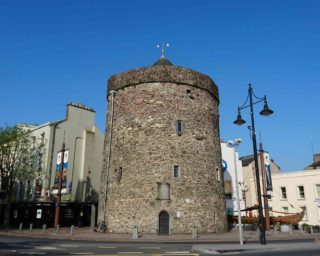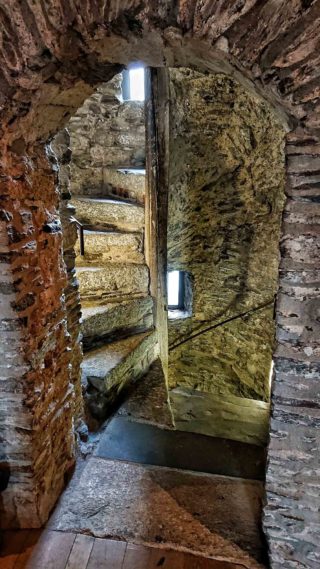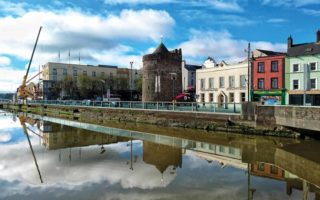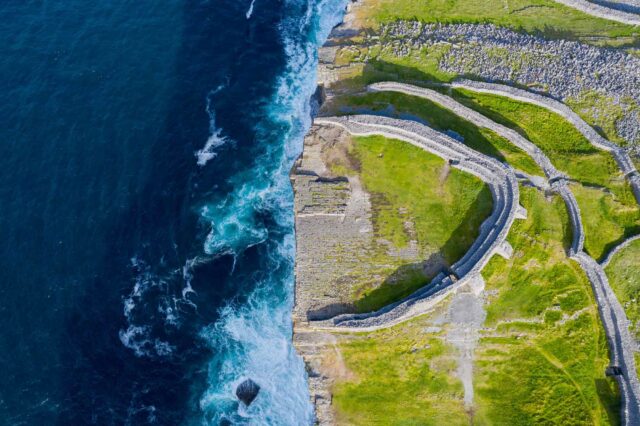Reginald’s Tower Highlights (8)

Reginald's Tower
Situated at the apex of Waterford’s Viking Triangle, Reginald’s Tower was once described as a vast hinge of stone! The Anglo-Norman settlement of Waterford was once protected by 23 towers and gate-houses and today Reginald’s Tower is the only one which stands fully intact. The history of the tower reaches right back to the foundation of the city in 914.

Stumble Stairs
Your first challenge as you make your way through the tower is to navigate the medieval stumble stairs. These may look very simple but a lot of thought went into the design of these stairs. As you climb the stairs you are following in the footsteps of the medieval attackers and defenders who tread these steps hundreds of years ago. As such you will notice that steps spiral to the right, so that it was virtually impossible for a right-handed attacker to swing a sword while advancing upwards, yet a right-handed defender could still attack on the way down. The steps are all different heights. No enemy could run up this fiendish staircase without tripping.

Fending Off Foes
Look for the arched openings on each floor with modern windows. Originally, defenders fired at the enemy from within through arrow-loop windows. Later these openings were modified to accommodate cannon. It was during Perkin Warbeck’s attack on Reginald’s Tower in 1495 that cannon were used in a siege in Ireland for the very first time. One of Warbeck’s ships foundered just outside.
Treasures of History
Waterford is Ireland’s oldest city, steeped in history. The city has three collections combined under the banner of Waterford Treasures. Housed in Reginald’s Tower are the Viking Treasures which include artifacts dating from Viking times, such as a kite brooch, gaming pieces and a dog collar. You can also see some silver coins that were actually cast here when the tower functioned as a mint. Perhaps the most unusual artefact on display, stuck in the outer wall, is a cannonball from Cromwell’s 1649 siege of Waterford. When you’re finished exploring the tower you can visit the Georgian and Medieval Treasures nearby.

The Monastery with three names!
Situated close by, and also a National Monument in State care, you will find the remains of the early 13th century Franciscan Friary. The ruins are also known as ‘The French Church’ and ‘Greyfriars’. This monastery was founded by Hugh Purcell in 1240 but was suppressed by Henry VIII in 1540. The colour of the habit worn by the monks is reflected in the name Greyfriars! In the late 1600’s fifty families of French Huguenot refugees arrived in the city following religious persecution in their homeland. The choir (the section nearest Reginald’s Tower) was converted to use for their services and so became known as the “French Church”. The Huguenots are also said to have brought a style of bread with them that was adopted locally and became known as the “Blaa”, a local delicacy now recognised and protected by the European Union.
Eight centuries of burials
For eight centuries the grounds of the French Church have been used as a burial ground, both within and without its walls. One of the better known of those buried here is Sir Neal O’Neille, the famous Irish General who fought with James II at the Battle of the Boyne. During the battle, while defending the fords at Rosnaree against Huguenot cavalry, he was seriously injured. When James II fled south to Waterford after the battle Sir Neal travelled with him but died of his injuries while in the city. He was buried in the choir of Greyfriars, ironically the very part given to the Huguenots for their services a short few years later.
How far can stone travel?!
The window openings in the east gable of the monastery are framed by beautifully carved, golden-yellow, limestone surrounds. The rock used however is not local but instead comes from the Dundry quarries near Bristol; it was imported by the Normans and used for decorative stonework. Other examples in the Viking Triangle can be found in Reginald’s Tower and Christchurch Cathedral. The outer wall of the nearby Waterford Treasures Medieval Museum is also faced with Dundry Stone, an acknowledgement to the historic use of this stone.
Look closer …
St. Francis of Assisi was renowned for his affinity with the natural world and he is now the patron saint of animals, the environment and ecologists. As a result birds and animals are often depicted in Franciscan houses and Greyfriars in Waterford was no exception. Today there are three surviving corbel stones with wildlife carved on them. Two show birds (one an owl, the other a snipe or oystercatcher) while the third, now located in the choir of the monastery, depicts a rabbit. Rabbits are not native to Ireland but were introduced by the Normans as a food source. The rabbit on display here in Greyfriars is somewhat unusual as he is wearing shoes!
Within the Viking Triangle, and all just a few minutes walk of the tower, are the other two museums of Waterford Treasures along with the House of Waterford Crystal, various craft shops and cafes. Ask the guides at the desk in the tower for a map showing the remains of the medieval gates and towers of the city or just enjoy a ramble along the streets and lanes which still follow the layout of the old city.
